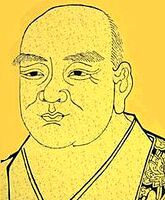Heze Shenhui
Jump to navigation
Jump to search
| English Phonetics | Shenhui |
|---|---|
| Chinese Script | 菏泽神會 |
| Japanese Transliteration | Kataku Jinne |
| Korean Transliteration | Hat’aek Sinhoe |
Dates
| Birth: | 684 |
|---|---|
| Death: | 758 |
| Place of birth: | Xiangyang in present-day Hubei province |
Tibetan calendar dates
About
Other Biographical info:
Links
- Wiki Pages
Buddha Nature Project
- Person description or short bio
- Chinese Chan master and reputed main disciple of the sixth patriarch Huineng; his collateral branch of Huineng’s lineage is sometimes referred to as the Heze school. Shenhui was a native of Xiangyang in present-day Hubei province. He became a monk under the master Haoyuan (d.u.) of the monastery of Kuochangsi in his hometown of Xiangyang. In 704, Shenhui received the full monastic precepts in Chang'an, and extant sources provide differing stories of Shenhui's whereabouts thereafter. He is said to have become a student of Shenxiu and later visited Mt. Caoxi where he studied under Huineng until the master's death in 713. After several years of traveling, Shenhui settled down in 720 at the monastery of Longxingsi in Nanyang (present-day Henan province). In 732, during an "unrestricted assembly" (wuzhe dahui) held at the monastery Dayunsi in Huatai, Shenhui engaged a monk by the name of Chongyuan (d.u.) and publicly criticized the so-called Bei zong (Northern school) of Shenxiu’s disciples Puji and Xiangmo Zang as being a mere collateral branch of Bodhidharma's lineage that upheld a gradualist soteriological teaching. Shenhui also argued that his teacher Huineng had received the orthodox transmission of Bodhidharma's lineage and his "sudden teaching" (dunjiao). In 745, Shenhui is said to have moved to the monastery of Hezesi in Luoyang, whence he acquired his toponym. He was cast out of Luoyang by a powerful Northern school follower in 753. Obeying an imperial edict, Shenhui relocated to the monastery of Kaiyuansi in Jingzhou (present-day Hubei province) and assisted the government financially by performing mass ordinations after the economic havoc wrought by the An Lushan rebellion in 755. He was later given the posthumous title Great Master Zhenzong (Authentic Tradition). Shenhui also plays a minor, yet important, role in the Liuzu tan jing ("Platform Sūtra of the Sixth Patriarch"). A treatise entitled the Xianzongji, preserved as part of the Jingde chuandeng lu, is attributed to Shenhui. Several other treatises attributed to Shenhui were also discovered at Dunhuang. Shenhui's approach to Chan practice was extremely influential in Guifeng Zongmi's attempts to reconcile different strands of Chan, and even doctrine, later in the Tang dynasty; through Zongmi, Shenhui's teachings also became a critical component of the Korean Sǒn master Pojo Chinul’s accounts of Chan soteriology and meditation. (Source: "Heze Shenhui." In The Princeton Dictionary of Buddhism, 349. Princeton University Press, 2014. http://www.jstor.org/stable/j.ctt46n41q.27.)
Expand to see this person's philosophical positions on Buddha-nature.
| Is Buddha-nature considered definitive or provisional? | |
|---|---|
| Position: | |
| Notes: | |
| All beings have Buddha-nature | |
| Position: | |
| If "Qualified", explain: | |
| Notes: | |
| Which Wheel Turning | |
| Position: | |
| Notes: | |
| Yogācāra vs Madhyamaka | |
| Position: | |
| Notes: | |
| Zhentong vs Rangtong | |
| Position: | |
| Notes: | |
| Promotes how many vehicles? | |
| Position: | |
| Notes: | |
| Analytic vs Meditative Tradition | |
| Position: | |
| Notes: | |
| What is Buddha-nature? | |
| Position: | |
| Notes: | |
| Svātantrika (རང་རྒྱུད་) vs Prāsaṅgika (ཐལ་འགྱུར་པ་) | |
| Position: | |
| Notes: | |
| Causal nature of the vajrapāda | |
| Position: | |
